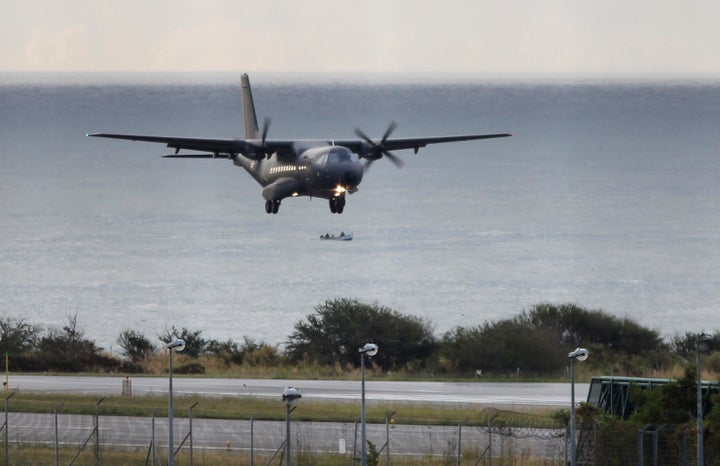
A French Air Force plane taking part in the search for wreckage from the missing MH370 plane lands in Saint-Marie on the island of La Reunion on Aug. 7, 2015.
Every week, The WorldPost asks an expert to shed light on a topic driving headlines around the world. Today, we speak with David Gallo about the latest developments in the search for flight MH370.
The recent discovery of plane debris in the Indian Ocean has raised hopes of finally solving the mystery of the Malaysia Airlines plane that vanished last year.
Malaysia said on Wednesday that the wing piece, called a flaperon, belonged to flight MH370, which went missing with 239 people on board on March 8, 2014, flying from Kuala Lumpur to Beijing. While French investigators were more cautious in providing a definitive link, they concur that the debris is a flaperon from a Boeing 777, and flight MH370 is the only plane of that type that is missing.
On Friday, France expanded its search for more debris around the Indian Ocean island of Reunion, where the flaperon was found. Meanwhile, experts continue to scrutinize the wing part for any clues on what happened to plane.
To better understand what these developments could reveal about the missing plane, The WorldPost spoke to David Gallo, director of special projects at Woods Hole Oceanographic Institution, who helped French authorities locate the wreckage of Air France flight 447 in 2011.
How difficult is it to trace back the path of the debris and find where the plane crashed?
It is extremely difficult. It would have been dispersed by winds and the ocean currents for 500-odd days. I don't think it will help refine the present search area in the short term.
But if the current underwater search doesn't find anything, and this remains the only piece of tangible evidence in 16 months of an international investigation -- and into possibly a criminal act -- it will become extremely important.
What will experts be looking for when they examine this object?
Firstly, how it sits in the water. Judging by the barnacles, which grow in sunlight, it looks like it was floating vertically, long side up. This is important because if it sticks above the water it will have been pushed by the wind, and if it was underwater it will have been pushed by the currents -- and these are often opposite directions.
Then, they will look at what the currents and winds were doing each day. It is very hard to backtrack all the way to the date it was lost. It's like finding a balloon on the East Coast of the U.S. and knowing it started on the West Coast -- could you backtrack and find its starting point? That's almost impossible to do. They will have to go back in time and see if the data exists and how detailed it is.
The barnacles could provide some clues -- their size could suggest the minimum length of time the object has been in the water. If they're a certain species of barnacle this could locate the debris in a smaller possible area. Often animals build their shells out of sea water, and the chemicals in them may be different in different areas.
Pollen is also a wonderful indicator of location. Anyone with a car knows that once pollen gets on your windscreen it can survive anything. Pollen, for example from off the Australian coast, could provide more information on the location.
The ocean is a great record keeper. The ocean sediment, rocks, coral, sea animals, ice caps -- they are all continuously recording the earth's history, and this is human history. We're right at the beginning of understanding what ocean forensics might do. The answers are out there. We just need to ask the right questions.
What clues might the debris offer about what happened to the plane?
The investigators will also look at the object itself -- whether it's dented, what the damage is like, and if it has nuts and bolts, whether they are skewed. It appears that the leading piece is in good shape while the tail is crumpled, and this could be due to fluttering in the air. This is important because it might tell you something about how this part came off the plane: whether it came off in the water or in the air, and if it came off in the air, whether it was from an explosion or a mechanical issue.
The investigators will go down to the grains of the metal and examine stresses and strains. This is what we did with Air France 477 and it provided compelling evidence that the plane landed on its belly, tail first -- that it came almost straight down and hit the ocean.
If their analysis shows the piece came off because of a sharp descent this will alter the current analysis that the plane was gliding for a certain time and distance and ran out of fuel. If it came off at supersonic speed, they'll have to shift the search area north.
From my experience I can promise that the French investigators will be completely thorough -- from the largest pieces to the individual grains of metal, they will be looking for any clues they can get.
Would you expect other debris to turn up in the same area around Reunion?
It's unlikely. The ocean is a great disperser. If you put five objects of different shapes in the water the ocean will tend to disperse them. Finding the items themselves is difficult; over time it begins to approach a question of luck. Depending on what the objects look like, they could be further north, or they could be on the other side of Australia.
How likely is it that rest of the plane will ever be found?
Time is not on our side. I don't understand why there wasn't action sooner when the debris field could have been more condensed. It is frustrating that there were a series of false claims at the beginning -- that debris had been found, or that pings were heard from the black box, which turned out to be shark tagging.
No one has done this routinely. The French had experience with Air France 447 and now the Australians, Malaysians and Chinese are all involved. It's difficult to work out what do and in what sequence.
The team that is searching now [the Australian-led search team scouring a 46,000 square mile area in the southern Indian Ocean] is the only team on Earth who can do the job. They faced a lot of criticism, as we did during the Air France 447 search, but they're the right team and have the right technology. I'm confident that if it's in the area they would have seen it, and I have to hope it's in the second half of the search area.
It may take time, but the plane will be found. The families have to have closure. And the flying public and the aeronautical industry have to know why it went down. There are also the families of the Air France 477 flight, the MH17 plane and the Germanwings jet to consider. Every time these things happen it opens old wounds and makes them deeper. I think it will be found --it just needs the will and the patience.
What frustrates me a lot is that after Air France 447, we said this can never happen again. There is a simple solution: get aircraft to broadcast their position every couple of minutes. Here we are a few years later and it happens again and in the worst possible way, and we still won't learn our lesson.
This interview has been edited and condensed for clarity.
Also on HuffPost:

